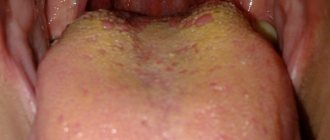Parents of a small child are worried about absolutely everything, including the color of the baby’s stool. This is not surprising, because even the color of stool can tell parents or a doctor a lot about the child’s condition.
On a note! Black feces in a child scares many parents, however, in most cases this symptom is absolutely normal. Only in rare cases does black stool in a child become a symptom of a disorder or pathology.
However, parents need to closely monitor the condition of their child and if there are any signs indicating the possibility of a pathological process, they should consult a doctor.
Possible reasons for stool turning black
A child may develop black stools for various reasons. Some factors are normal and do not pose any danger, while others need to be addressed urgently. That is why it is important to understand why a child has black stool. The following phenomena and reasons can affect the coloring of stool:
- Bowel movement in the first days of life. The fact is that babies are not born with an empty intestine, but with meconium inside. This term refers to fecal matter consisting of prenatal hair and epithelial cells, mucus, bile and water. The child swallows these particles along with amniotic fluid. Black feces in a newborn are observed only for the first 2-3 days, then meconium completely leaves the intestines, and the color of the feces becomes yellow.
- Using a mixture with a high iron content. Darkening of the stool can be caused by switching to a new formula that contains a lot of iron. This reaction is absolutely normal, since iron oxidation occurs in the stomach. Next, the substance is mixed with feces and colors them black.
- Introduction of complementary foods. In the first year of life, the child’s intestines are just beginning to adapt to work and external influences. At this time, the digestive system is still learning to digest foods, so the introduced complementary foods do not undergo complete processing. During this period, as a rule, black spots are observed in the stool. In addition, particles of undigested food can also be found among the stool.
- Nutritional features. Your baby may develop dark stools as a result of eating certain foods. For example, beets, currants, cherries, blackberries, and prunes have coloring properties. As well as liver, kidneys, apples, pomegranate and some other foods high in iron. The stool may be completely dark in color or have black specks if the food is not completely digested. In this case, black poop can persist for the next two or three days.
- Application of vitamins and minerals. Doctors often prescribe special complexes for children with a lack of vitamins and minerals. If they contain iron, the child will empty his intestines with black feces. Sometimes a change in the color of stool occurs due to the use of hematogen.
- Taking activated carbon. This substance is not absorbed into the blood and is not digested by the intestines. Activated carbon is a sorbent that absorbs all harmful substances and then removes them out. Parents often note black, fairly large inclusions in their stool.
- Taking medications. Some medications, for example, paracetamol, ibuprofen, antibiotics, as well as products containing bismuth, can affect the color of a child’s stool.
These factors are harmless and go away on their own after 2-3 days. Or after changing your diet and stopping taking certain medications. However, in some cases, a change in the color of stool is explained by the presence of inflammation or other pathologies in the organs of the digestive system. In this case, the black color of the stool, as well as various grains of sand and specks, are an alarming sign.
Dietary recommendations
Since most often changes in the color of stool in children are more associated with foods rather than internal diseases, it is important to pay great attention to nutritional issues. So, during the lactation period, a woman should organize her diet. Do not overuse herbs and foods with dyes.
In order for the baby to avoid nutritional deficiencies while living on breast milk, it is necessary to monitor one more factor. According to research, first of all, the child drinks the part of the milk less saturated with useful substances, which is located in the near part of the breast. Therefore, if the feeling of fullness comes before he has reached the thickest and most nutritious part of mother's milk, which is located further, he will not receive the required amount of vitamins.
Important: If this is detected, it is necessary to increase the breaks between feedings. Or otherwise regulate the child’s appetites.
After switching to artificial nutrition, it is worth adjusting the amount of iron-containing foods so that the body gradually gets used to assimilation of the new element. This applies to vitamin complexes, dietary supplements and preparations containing iron.
You need to be careful if you have to give your baby antibiotics. You should not prescribe self-medication without consulting your doctor. And during the treatment process, it is necessary to monitor changes in stool in order to prevent dysbacteriosis in time.
Diseases that can cause black stool
Black spots in the stool of an infant, or simply a change in the color of the stool to black, at this age sometimes indicate diseases of the gastrointestinal tract. Such pathologies are quite rare in children under one year of age, however, there is still a possibility. Most often, the black color of stool indicates bleeding in the digestive tract, which is a very dangerous deviation from the norm.
Along with bleeding, other associated symptoms are usually observed. For example, internal bleeding is almost always accompanied by nausea and vomiting, general weakness of the body, dizziness, pain in the abdominal area and constipation. Sometimes you can find bloody streaks in the stool if the bleeding occurs in the lower part of the intestine. In addition, sometimes parents notice mucus in their child’s stool. If you notice such symptoms, you should immediately consult a doctor or call an ambulance.
If the color of the stool and consistency are normal, and the baby feels well, is not worried and eats normally, it is possible that the cause of small inclusions of blood is a rupture of the anus. This happens to children, especially with constipation. The rupture, as a rule, is insignificant; it’s just that a small artery passes through its place, which was the reason for the appearance of blood in the stool. The most reliable indicator of a baby's health is its condition. When there are painful symptoms inside, children always cry, act restless and refuse to eat. Therefore, black feces in combination with such signs is a very dangerous sign.
Other facts about baby chairs that parents should know
Black stool in babies is a concern for parents, but from time to time you may notice other changes in the consistency and color of the stool.
Red chair
This is usually blood, so it makes sense to talk to your doctor, especially when this change persists. The baby may have a small crack on the inside of the anus when hard stool passes through, sometimes causing bleeding. If this is the case, your doctor will recommend drinking more fluids, prunes, and fiber to soften your stool.
Red stools may be the result of taking antibiotics that combine with iron.
Certain foods and drinks, such as red juice, can cause stool to appear colored.
Green chair
Green stool is usually the result of stool moving too quickly through a baby's intestines. This is not a cause for concern, especially in infants. But the child must gain weight well.
Green stool can also be the result of eating a lot of fiber foods (broccoli or other green vegetables). In some cases, the green color is due to the use of dyes in the food or drinks that the child consumes.
Yellow chair
In addition to black stools, the child sometimes has yellow stools. Don't worry about yellow stool if you are breastfeeding. Sometimes it looks like mustard in the diaper after feeding.
White chair
While gray or chalky stools are usually not a sign of abnormality, they are often the result of the child eating something unusual. You should tell your pediatrician if this occurs repeatedly. Rarely, it is associated with liver problems or another medical condition.
Thus, black stool in itself is not dangerous. But this is a possible signal of serious diseases in the body that threaten life if timely help is not provided. On the other hand, this is often explained by the banal consumption of certain foods that turn the stool an unusual color. In any case, do not be squeamish when studying the condition of your child’s stool. Nature is intelligent - it has provided a whole system of signs and signals that make a person wonder whether his body is in order.
kroha.info
How to provide first aid?
If you find other alarming signs in your baby along with black feces, you need to call a doctor and try to alleviate the child’s condition.
- Firstly, the baby needs to be provided with bed rest.
- Before the doctor arrives, you cannot give any food, you can only give cold water.
- It is recommended that you do not throw away stool and show it to your doctor first. Upon arrival, the specialist will examine the baby, provide first aid and refer for additional examinations, for example, stool, urine and blood tests, as well as ultrasound and gastroscopy, which will help identify the cause of the symptom and then prescribe the correct treatment.
Parents whose child already has a history of diseases of the digestive tract should be most concerned about black stool in their baby. For example, if a child has gastritis, peptic ulcer, Crohn's disease, stomach or intestinal cancer. Particular attention to the color of stool should be paid to parents of a child suffering from hepatitis or cirrhosis of the liver.
What should parents do?
1. First, think about what foods your baby has recently eaten at home, on a visit, or at school. Does he take vitamin complexes or drugs to treat anemia? If you suspect some food or medicine is responsible, then monitor your baby for a few more days. The condition should not worsen.
2. If the color of the stool disappears on its own and appears from time to time, and is not associated with food, then tell your doctor about your observations. The child may need to be examined.
3. How is the child feeling? If the symptom is combined with abdominal pain, bloating, vomiting, dizziness and severe pallor, then consultation with a doctor is mandatory and the sooner the better.
chudomamochka.ru
Child health problems
In some cases, dark stool may indicate certain health problems.
Basically, darkening of feces occurs due to internal bleeding in the gastrointestinal tract.
This condition is a cause for concern, since severe blood loss leads to a deterioration in the child’s condition.
The baby may develop iron deficiency anemia, which is characterized by shortness of breath, increased heart rate and further loss of consciousness. If neglected, severe blood loss can be fatal.
Internal bleeding is usually accompanied by other symptoms. The baby becomes lethargic, gets tired quickly, nausea, vomiting, and abdominal pain appear. In some cases, body temperature may increase.
If the above symptoms are observed along with dark stool, then you should urgently consult a doctor, since internal bleeding is very dangerous to health and is characteristic of gastric or intestinal ulcers, gastritis, diverticulitis (protrusion of the walls of a hollow organ).
In addition, dark stool may indicate the development of Crohn's disease, hemorrhoids, and the appearance of tumors in the colon.
It is extremely rare to find hepatitis or cirrhosis of the liver in children, which also contribute to the darkening of feces.
Quite often, the dark color of stool indicates the presence of intestinal infections in the body. In this case, the feces will be black with a greenish tint and often emit an unpleasant odor.
The child’s health is poor, there is vomiting, which can lead to rapid dehydration, the baby falling into a coma and even death.
If you have such symptoms, you should definitely call an ambulance, and not try to fix the problems yourself or blame everything on iron-containing products.
Having discovered darkening of a child’s stool, parents should not panic, but analyze what their baby has recently eaten.
If there were no foods in the diet that could cause dark colored feces during bowel movements, and no medications with the same side effects were taken, then this is a reason to consult a doctor.
You should definitely visit the hospital if other symptoms of deterioration in health are observed along with dark stool. In some cases, darkening of feces can be a sign of serious illness.
Parents of a small child are worried about absolutely everything, including the color of the baby’s stool. This is not surprising, because even the color of stool can tell parents or a doctor a lot about the child’s condition.
On a note! Black feces in a child scares many parents, however, in most cases this symptom is absolutely normal. Only in rare cases does black stool in a child become a symptom of a disorder or pathology.
However, parents need to closely monitor the condition of their child and if there are any signs indicating the possibility of a pathological process, they should consult a doctor.
Diagnostics
If in doubt, visit a doctor!
A change in the color of stool alone is not a sufficient diagnostic criterion for internal bleeding. The doctor will need to confirm the presence of blood in the stool using various methods.
Sometimes examining the anal area is sufficient, but more often laboratory and instrumental diagnostic methods are used.
Laboratory methods can detect even small amounts of blood in the stool. The method is called a fecal occult blood test. Special substances are used to detect blood components. To speed up diagnosis, you can collect material for analysis at home.
Once the presence of blood in the stool is confirmed, the doctor will need to determine the cause and source of the bleeding. The most commonly used method is esophagogastroduodenoscopy.
Using this study, it is possible to assess the condition of the mucous membrane of the esophagus, stomach and duodenum. Any damage will immediately attract attention. Other diagnostic methods:
- Radiography using barium sulfate.
- Computed and magnetic resonance imaging.
- Blood analysis.
- Colonoscopy (endoscopic examination of the intestines).
Accurate determination of the cause of melena or pseudomelena is important for prescribing treatment.
Melena
Stool can be different shades for each person
As already mentioned, the appearance of black stools may indicate bleeding in the upper digestive tract.
The red color of blood is due to iron-containing hemoglobin. Any changes in blood color are also caused by chemical changes in hemoglobin molecules.
In the stomach, digestive juices act on the blood, which can cause black stools or vomit the color of coffee grounds. Doctors call this type of stool melena.
It is also important to be able to distinguish signs of bleeding in different parts of the digestive tract. Blood released below the stomach may be bright red, burgundy or crimson in color. This condition is called hematochezia.
The appearance of stool of a different color is explained by the fact that in the intestine food is exposed to the influence of other enzymatic environments. Bright red or scarlet blood almost always indicates bleeding in the colon or rectum.
Basic information
Black stool can be a serious symptom
People often pay attention to the nature of their discharge. A change in the color of urine or stool often causes alarm and is a reason to consult a doctor. Normal stools are brown in color because the stool contains bile residues.
If food is digested faster than expected, the stool may acquire a greenish tint due to insufficient decomposition of bile. White stool may indicate blockage of the bile ducts.
In medical practice, black tarry stools are primarily associated with hemorrhage in the esophagus or stomach. The fact is that the blood released in the upper parts of the digestive tract undergoes chemical decomposition during the digestion of food.
It takes a long time before such blood reaches the rectum. As a result, the blood turns black. In contrast, blood released in the lower intestines will have a characteristic bright red color.
Fortunately, bleeding is not the most common cause of dark stool. This color can be the result of food eaten, metabolic characteristics, or diseases. However, any change in a child's stool should be a reason for diagnosis, since the health of the digestive system is of primary importance for a growing organism.











